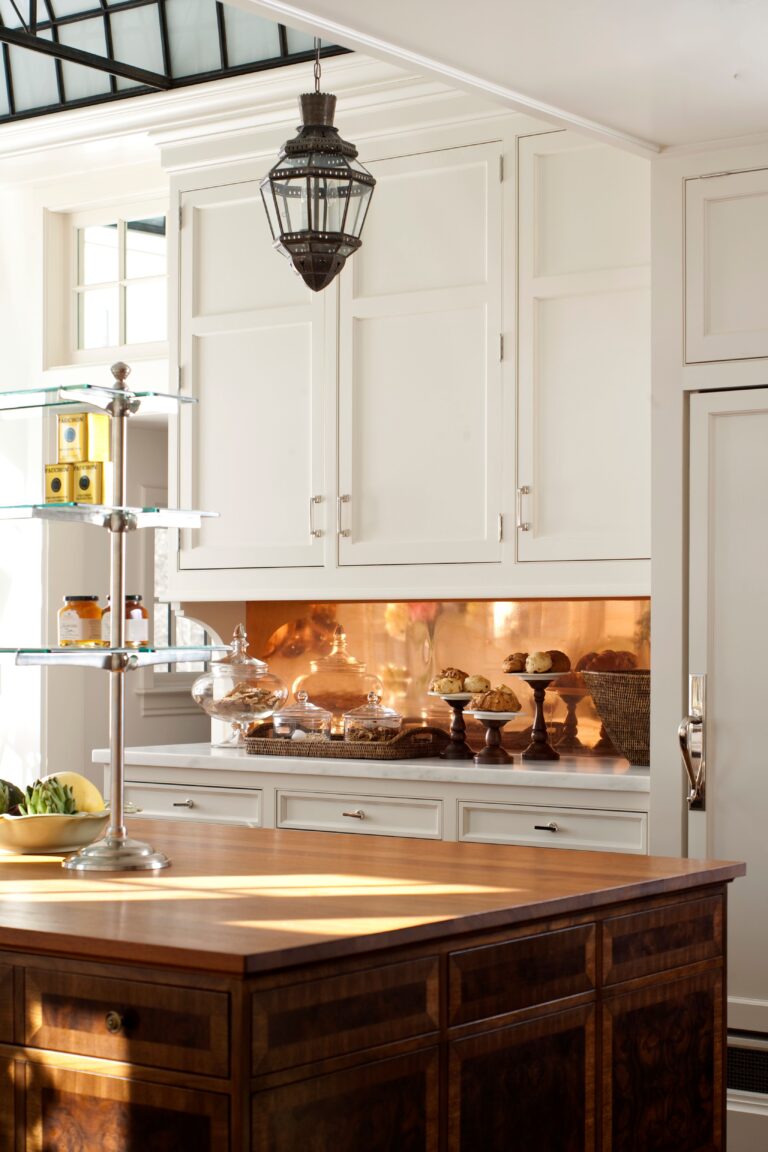When you think of metal kitchen finishes, stainless steel probably comes to mind. But what about its polar opposite: copper? More and more homeowners are incorporating this warm metal into their kitchens for a variety of reasons. So much so that a recent Houzz Emerging Trends Report highlighted copper backsplashes as a highly popular finish. We asked a few design experts about the trend and how you can incorporate it into your home.
- Mitchell Parker She's a senior editor at Houzz, an interior design website and resource.
- Victoria Holly She works as an interior designer with her own company, Victoria Holly Interiors.
- Ginger Curtis She is an interior designer and founder of Urbanology Designs.
- Jerad Galdemar works as an interior designer for a company called JF Gardemal Designs.
“Copper suits any part of the home, but interest is growing especially as a material for backsplashes,” says Mitchell Parker, senior editor at Houzz. “Copper can take center stage in the kitchen, where it can create a warm and beautiful look whether it's polished to perfection or weathered and worn.”
Copper's warm, natural look lends itself to a wide range of kitchen styles. Copper can be decorative or simple, and it blends equally well into traditional and contemporary spaces. Get inspiration for your own kitchen with our guide to copper backsplashes, including design ideas, care and maintenance tips.
John Bessler
Advantages of Copper Backsplash
“Copper backsplashes are a great choice for those who want the warmth of a metal but want to avoid the trendy brass look,” says Victoria Holley, president and founder of Victoria Holley Interiors. “Copper has a warm, inviting feel that can instantly elevate the ambiance of your kitchen.”
Copper backsplashes also develop character over time. Backsplashes made from real copper will patina with use and time, changing to a richer color as the metal reacts with oxygen and moisture in the air and oxidizes. Unfinished copper oxidizes to a vibrant blue-green color, which helps protect the metal from further corrosion. “The patina and worn look that aged copper develops over time gives it a sense of history and authenticity, making it a great choice for anyone who likes a vintage aesthetic,” says designer Ginger Curtis of Urbanology Design.
Aesthetically pleasing aside, a big benefit of a copper backsplash is its naturally antibacterial properties: “It's said to be more resistant to bacteria than stainless steel, making it a practical choice for kitchens,” says Parker.
Additionally, copper is highly durable, another benefit to consider when choosing materials to decorate a high-traffic room like the kitchen.
David A. Rand
How to Style a Copper Backsplash
Copper is perfect for those who appreciate natural materials and who seek elegance and luxury. Available in a wide variety of shapes, colors and finishes, from large, smooth copper sheets to hammered copper tiles, you have plenty of options to create the perfect copper backsplash for your kitchen.
Traditional Copper Backsplash
With its warm tones and subtle shine, a copper backsplash is perfect for a traditional-style kitchen. “For a more traditional kitchen, try a textured copper backsplash or pattern,” says Curtis. “This style adds depth and character, complementing the warmth and charm often found in traditional kitchens.”
For traditional kitchens, designer Jerad Gardemal of JF Gardemal Designs suggests using stamped copper tile or stamped copper sheet. While either option is more expensive than a typical tile backsplash, he points out, “copper's beauty and durability are timeless and chic.”
Modern copper backsplash
The warmth that makes copper a natural fit in a traditional space is the same quality that makes it stand out in modern kitchens, where cooler metals like stainless steel and chrome are often used.
“Clean lines and polished or brushed copper surfaces can provide a striking contrast to minimalist cabinetry and countertops,” says Curtis. “Combining contemporary design elements with the warmth of copper can create a visually appealing focal point in your kitchen.”
Additionally, the reflective properties of the polished copper backsplash gently bounce light around the minimalist kitchen.
Julie Sufer
How to Clean a Copper Backsplash
How and how often you clean your copper backsplash will depend on your preference for the finish and patina. If your copper backsplash has a very strong lacquer and seal, a simple clean with mild soap and warm water will suffice, as harsh chemicals can strip away the protective coating.
Unfinished copper, on the other hand, will develop a patina over time due to oxidation. If you want to limit this reaction, limit regular cleaning of your unfinished copper backsplash to every three to six months. “Wipe with warm, soapy water and a soft cloth will maintain the integrity of the copper and keep it shining,” says Gardemal.
But if you want to remove copper tarnish or restore your copper to its lustrous shine, you can make an effective solution at home.
- Make a paste by mixing an acid, such as lemon juice or vinegar, with a mild abrasive, such as salt or baking soda.
- Using a soft cloth, gently rub the copper with the paste, using small circular movements.
- Use a damp cloth to wash off the paste.
- Thoroughly dry the copper backsplash with a microfiber cloth.
Edmund Burr
Get the look of a copper backsplash without the hassle
If you want the look of a copper backsplash but want less maintenance and costs, there are a variety of alternatives available, including glass tile and painted copper look options.
Curtis suggests using copper veneer or copper foil, “which have a copper look but are more affordable and easier to maintain. Copper laminate and metallic tile are also options that will give you a copper look without the hassle.”
Copper-colored stainless steel is a low-maintenance option that allows you to achieve the look of copper without the risk of oxidation or the need for regular polishing to maintain the patina.


